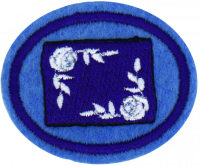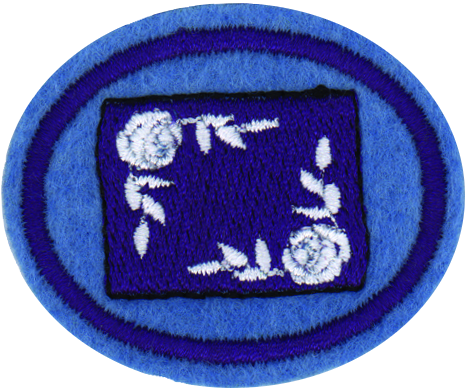AY Honor Glass Etching Answer Key
1
- Aprons and gloves
- Glass etching involves the use of acids, so the safety of your Pathfinders should be your utmost concern.
- Exacto knives
- To cut out traced design from contact paper.
- Contact paper
- To protect the area you DON'T want etched.
- Carbon paper
- To copy designs.
- Etching cream
- Typically, "glass etching cream" available from art supply stores consists of fluoride compounds, such as sodium fluoride and hydrogen fluoride. The fluoridation of the glass causes the characteristic rough, opaque qualities of frosted glass.
- Paint brushes
- To apply etching cream.
- Newspaper
- To protect the surface that you work on.
- Rubbing Alcohol
- To clean off the glue left from the contact paper.
- Window cleaner
- To wash the glass before working on it.
- Colored Masking tape
- To put around the edge of the finished mirror.
- Scissors
- To cut contact paper.
- Timer
- (optional, a cellphone or watch works just as well.) To time how long the etching cream has been on.
- Cotton swabs (e.g. Q-tips)
- To apply the rubbing alcohol.
- Pens and Pencils
- To draw/trace the chosen pattern onto the contact paper.
- Paper towels
- To wipe off window cleaner.
- Stencils
- (optional) For ready-made patterns and ideas.
- Glass projects
- Items made from glass that you want to work on. You'll need small mirrors, small pieces of glass, and round glassware. The mirrors and small pieces of glass can be found at most craft stores. These will have finished edges that are safer to work with. Round glassware (vases, drinking glasses, jars, etc) can be found at "dollar" stores (such as Dollar Tree). You can also use baby food jars for the round item. It's best to get round-ware that is straight in the vertical dimension (i.e., a cylinder rather than something curved in three dimensions). This makes is possible to use contact paper as a mask.
2
- Clean the glass with window cleaner and paper towels.
- Choose a design and plan how you want it to look.
- Cut contact paper to fit over the ENTIRE project and put it on the project.
- Rub out all air bubbles.(I've found it's easiest to do this while putting on the contact paper.)
- Trace stencil pattern on to the contact paper. If you are using an original design, draw the design on white paper. Then put carbon paper over the contact paper-covered glass, making sure to cover the area where the design will be. Now put the paper with the design over the carbon paper, and heavily trace the design.
- Cut out the design from the contact paper with the exacto knife, by going over the lines with the knife.
- Peal off the design, so that all the glass, except the design, is covered with contact paper.
- Remove the glue residue within the design area with alcohol, by using cotton swabs.
- Apply etching solution in even brush stokes, going up/down and side to side, covering the exposed glass. Leave it on for the specified length of time.
- When the time is up, rinse the glass so that no etching cream remains, and then dry with paper towels. Peal off the contact paper, and wash the glass with window cleaner.
- Mount and display the finished project.
3
Velvet etch is a brand of reusable etching cream. Other brands are available that may have different standing time for the etch. When you apply the etch, you need to brush it on with even, up/down, side to side, brush strokes. Apply etch with a generous amount on the project. Let it stand for five minutes. Wash off with warm water.
4
- a. Lettering or verses.
- b. Flowers, animals, or people.
Follow the procedure outlined in requirement 2.
You can buy what is called "memory glass" at most craft stores. Also, if you can't find any, you can cut big pieces of glass into smaller pieces, though glass cutting is a task that requires some skill.
You can find all the supplies at craft stores and household-goods stores.(e.g. Fred Meyer...)
Design options vary depending on the size of glass you have. Since this is your first project, unless you are a good artist, it's nice to have small, uncomplicated stencils to work with.
5
- a. Lettering, verses, flowers, animals, or people.
- b. Finish by framing around mirror with colored tape.
Small mirrors can be bought at most craft stores. Look for mirrors with finished edges so that your Pathfinders are unlikely to cut themselves while working with them. There are no significant differences between etching mirrors and etching glass, just be sure to etch the front side of the mirror. Most mirrors are made by applying a reflective coating to a sheet of glass. The side of the glass without the coating is the reflective side, and that's the side that should be etched.
6
When etching a drinking glass, jar or oval object, you may want to lay it on its side instead of etching it upright. Either way is fine. If you are doing designs all the way around the object, you will want it to be upright or tipped, not on its side. If you opt to lay the object on its side, keep tabs on it to make sure it doesn't roll off the table when your back is turned. However, there is nothing special to keep it from rolling. The contact paper needs to be applied all the way around. The reason is to keep the etching cream from dripping on any part of the object you do not want etched. This is especially true if the object is on its side.


